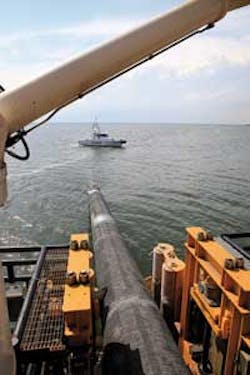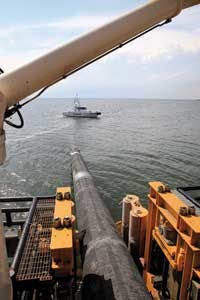Nord Stream completes world's longest subsea pipeline
Bruce BeaubouefManaging Editor
With the completion of Line 1, developers of the €7.4-billion ($10-billion) Nord Stream pipeline project have realized the ambitious goal of moving Russian gas to European markets directly through the Baltic Sea.
First announced in 2001, the project called for construction of two parallel 759-mi, 48-in. pipelines to move natural gas from Vyborg, Russia, to Lubmin, near Greifswald, Germany. The Nord Stream consortium includes Gazprom, Wintershall, E.ON Ruhrgas, Gasunie, and GDF SUEZ.
Saipem'sCastoro Dieci pipelay vessel worked in the Bay of Greifswald, Germany, from June to October 2010. Designed to operate in shallow waters, it installed 28 km (17 mi) of each of the twin pipelines in that area. Photo courtesy Nord Stream.
In early November, the developers announced that Line 1 had become operational, and that gas is now flowing to Lubmin, Germany, where Nord Stream is connected to the European gas grid. Line 1 is expected to be able to move up to 27.5 bcm (971 bcf) of gas on an annual basis.
Pipelay activities were completed on Line 1 in June, making Nord Stream the longest subsea pipeline in the world, surpassing the recently completed Ormen Lange gas pipeline (which runs about 725 mi, or 1,167 km, in the North Sea).
Construction of Nord Stream Line 2 is also progressing on schedule, and some 600 km (373 mi) of this line have been installed to date. Pipelay on this line is expected to be completed in 3Q 2012, and the line is scheduled to become operational before the end of next year.
Building the first Nord Stream pipeline was a major engineering and construction accomplishment. Because it passes through the waters of five countries and could affect others, an extensive permitting and consultation process had to be followed. The twin pipeline system runs through the exclusive economic zones and territorial waters of Russia, Finland, Sweden, Denmark, and Germany. The nations of Poland, Latvia, Lithuania, and Estonia were designated as affected parties.
An important part of the process focused on preserving safety and reducing environmental impact. The consortium invested €100 million ($135.5 million) and engaged in extensive dialogue and consultations with governments, authorities, experts, and stakeholders in all Baltic Sea states to ensure that the design, routing, construction, and operation of the pipeline will be safe and environmentally sound. The terrain along the route was carefully researched and cleared in preparation for the pipe laying, and Nord Stream was routed to keep clear of munitions dump sites. Construction was scheduled to avoid environmental impact and not interfere with critical seal breeding and fish spawning seasons. With these concerns addressed, the required permits were received in February 2010, and construction of Line 1 began the following April.
Preliminary engineering design was performed by INTEC Engineering (now INTECSEA); with the detailed design engineering conducted by Snamprogetti. Saipem and its subcontractor Allseas carried out the offshore pipelaying activities. A joint venture of Royal Boskalis Westminster, and Tideway did the pre-lay seabed dredging work.
The line pipe was manufactured by EUROPIPE, OMK, and Sumitomo Heavy Industries, with the concrete weight coating and logistics services provided by EUPEC PipeCoatings S.A. For the concrete weight coating, new plants were constructed in Mukran (Germany) and Kotka (Finland). Each pipeline will be comprised of 100,000 12-m (39-ft) long concrete-weight coated steel pipe joints, each weighing around 23 metric tons (25 tons). For the construction period, Nord Stream created a logistics center in Gotland (Sweden); and other interim stock yards were located in Mukran, Kotka, Hanko (Finland), and Karlshamn (Sweden) to continuously supply the concrete-coated pipe joints to the lay barges.
Since plans called for the pipeline to be laid in three sections, Saipem organized three laybarge vessels, two with special requirements. Its pipelay vesselCastoro Dieci, designed to operate in shallow waters, worked in the Bay of Greifswald, Germany. It installed 28 km (17 mi) of each of the twin pipelines, working from June to October 2010.
The AllseasSolitaire – the biggest pipelay vessel in the world – installed a 342.5-km (212.8-mi) segment of each of the twin pipelines offshore Finland, starting in September 2010 and completing in August 2011. With its dynamic positioning system, the Solitaire was ideally suited for working in the congested Gulf of Finland.
Saipem'sCastoro Sei installed about 70% of Line 1, some 853.5 km (530.4 mi). It started work on Line 1 in April 2010, and finished in May 2011. It began work on Line 2 this past June, and is expected to complete pipelay activities on Line 2 in 3Q 2012.
The final weld connecting the offshore and onshore parts of Line 1 was completed in August, and all three sections were joined using underwater hyperbaric tie-ins. These tie-ins were conducted at two locations. The connection of the Gulf of Finland and central sections took place offshore Finland in a water depth of 80 m (262 ft). Linking of the central and southwestern sections was performed in 110 m (361 ft) of water off the Swedish island of Gotland. Each tie-in was conducted in an underwater welding habitat and remotely controlled from the Technip DSVSkandi Arctic.
A key design element for Line 1 is that the system will operate without an intermediate compressor station, which will lower operational costs and reduce CO2 emissions. Gas travels the full 759 mi distance thanks to the 220 bar pressure generated at the Portovaya compressor station near Vyborg. The pipeline has a constant internal diameter of 1,153 mm (approx. 45 in.), but the system was designed to have three different design pressure sections (220, 200, and 177.5 bar) and pipe wall thicknesses (34.4, 30.9 and 26.8 mm; or 1.35, 1.21 and 1.055 in., respectively) corresponding to the gas pressure drop over the long journey from Russia to Germany. By designing each section according to the changing pressures, Nord Stream was able to save on the amount of steel used, and thus the cost of the pipe.
When the second line is completed in 2012, Nord Stream will have the capacity to move 55 bcm/yr (1,942 bcf/yr) to the European gas network.
Offshore Articles Archives
View Oil and Gas Articles on PennEnergy.com

